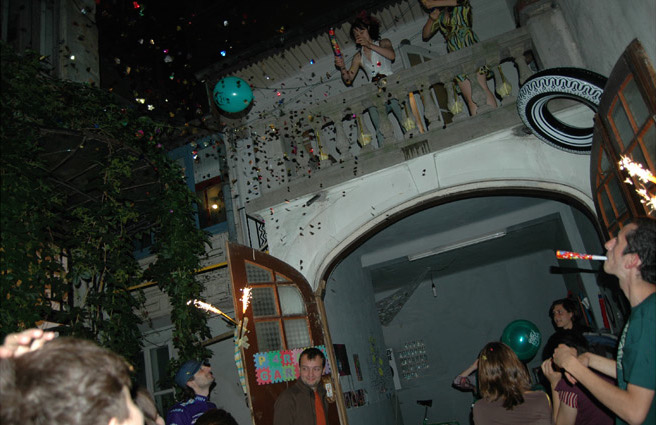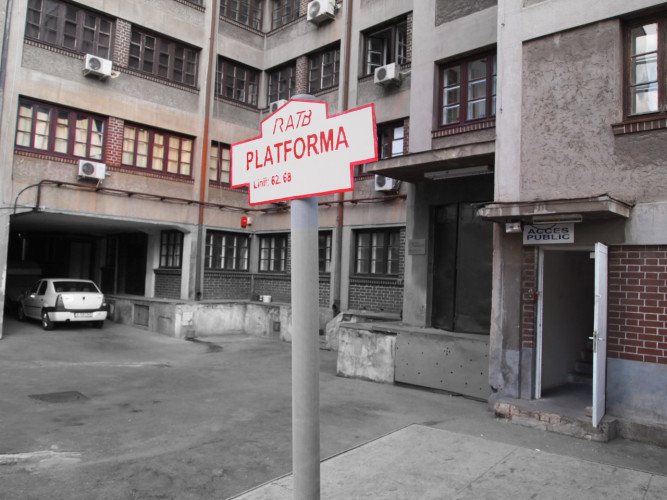Dear Simona,
I would like to begin with no protocol this time, and get straight to the point.
First off, let me thank you with an enthusiasm which I immediately felt as I read your extremely witty, pertinent, sincere and thus very necessary text.
Secondly, I will answer a question that isn’t mentioned in your text, but that I read somewhere between the lines, and more so, I’ve asked myself this question countless times since last March. Why didn’t I invite Paradis Garaj / Kunsthalle Batiștei to this discussion. The most direct and honest answer would be: out of ignorance. Firstly because this institution that is represented by its founder, the visual artist Claudiu Cobilanschi, was present in the pages of the book that started all this, next to Corina L. Apostol, thinking that their taking part in this discussion is, thus, self-explanatory. Then, because Paradis Garaj is too much of a paradigm, a handy example that is too often cited in any essay on mapping the local artist-run scene, when in fact, artist-run spaces are the norm for the Bucharest contemporary art scene, and not the exception. All in all, the preliminary conclusion would be, as you have guessed, Paradis Garaj’s absence from the round table is inexplicable and unjustifiable, all the more inexplicable and unjustifiable that I, myself, had an intervention within that space, a manifesto-exhibition called Cheap replicas, that took place during the White Night of Galleries in 2009.
Now then, I can read two points of tension in your text: the dysfunction of the autosuggestion paradigm and a certain amount of epistemological restlessness towards the appetite for history within our discussion at tranzit.ro/Bucharest.
The dysfunction of the autosuggestion paradigm that you managed to describe so well with the fever of applications to all sorts of funds and other institutional structures authorized by The West in order to maintain The Golden Calf mirage throughout the local cultural communities, has now, with applications already knocking at the door, lingered ever since the debate and was relevantly summed up by Delia Popa’s wondering: how can we take part in perpetuating the neo-liberal self-management ideology, when our entire activity was built upon the exact opposite – on cooperating and exchanging knowledge without taking part in the market economy? The answer took off like a butterfly from its cocoon in your own text: we cooperate without a hunger for competition, yes, but when it comes to an application, and if it isn’t an application then it’s one of two things: activity that is regulated by the private laws of the labor code within the state system and / or activity that bends the rules in the name of the illusion of independence, while succumbing to a much more drastic code, the corporate code. The cooperative and the corporation are forms of art circulation and sharing molded by this autosuggestion paradigm that the applications encourage each year. And the Pavlovian answer we provide each year, on this occasion, is also the safe definition of the collaborationism within this paradigm that we cannot shake off, unless we question the very pseudorepresentative nature of the government that manages it. Solidary, cooperative, radical and refusenik.
In other words, it’s not about the fact that our activity depends on public funds creates this dysfunction (after all, these funds belong to us), but, always, invariably, it’s about the neo-liberal fundamental meritocratic way of operating the selection of “winners” that is so deeply rooted in our western culture ever since the setting of the education system based on grades and prizes. Artistic work, along with games, is the human activity that is the second most profoundly allergic and stubborn to the competition system. The first and most prompt effect of any competitive initiative is the annihilation of interest in any type of creative activity altogether. As for games, I will only invoke the name of Jurgis Baltrusaitis. Cultural parades aside, I think we should ask ourselves, when we start to coagulate in artist institutional forms, ok, if the interest, curiosity, urgency, helplessness of not making art go away within the frame of the competitive system of complaining about funding, what takes their place? Commercial galleries and art fairs know how to answer this question all too well.
These were the reasons why we had to start off with a little art history in our debate at Tranzit.ro, in order to compare the the art institutions’ way of working in the planned economy before 1989, in the transitional economy of the 90s and the capitalist economy of today, and I am still convinced that, as the philosopher Ovidiu Țichindeleanu warned us at some point, “society’s anachronisms come not from the incapacity to follow a foreign model, but from not owning up to our own local history”. This explains not only the paradoxical post-communist utopia of Bucharest artist-run spaces, but also the dysfunctionality of of the current institutional system in which contemporary art is trying to self perpetuate itself, beginning and ending with the same Museum of Contemporary Art.
The text was written on May 5th, 2015.
POSTED BY
Igor Mocanu
Igor is a PhD researcher in the Art History department of the National University of the Arts Bucharest / UNARTE, with a dissertation titled Political avant-garde. The other face of Romanian avantgard...
igormocanu.wordpress.com


Comments are closed here.